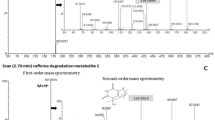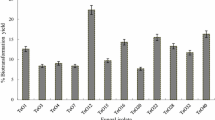Abstract
Kombucha tea is a consortium of yeasts and bacteria (predominantly acetic acid ones). One caffeine-degrading yeast was isolated from kombucha tea, identified using 18S rRNA sequencing and phylogenetic analysis, and classified as Pichia manshurica CD1 (GenBank accession number KY799109). The strain was found to able not only to degrade caffeine, but also to use it as a sole source of carbon and nitrogen. In such a caffeine medium the strain required about two days of incubation to reach maximum growth. An NBT-dependent (nitro blue tetrazolium chloride), caffeine dehydrogenase activity assay was established and the enzyme was purified. It was found that the caffeine dehydrogenase was a monomer of approximately 85 kDa and had optimal activity at pH 7.5. Interestingly, the enzyme showed high activity and stability over a wide range of temperatures, with almost 71% of activity being retained after incubation at 55°C for 20 min and 54% of its initial activity was retained even after incubation at 100°C. The purified caffeine dehydrogenase had high substrate specificity towards caffeine (Km 11.2 µM and Vmax 0.372 nmol/(mL min)) at 0.5 mM concentration. The enzyme activity was partially inhibited in the presence of Cr2+, Pb2+, Zn2+, Ni2+, Hg2+, and Mg2+ at 1 mM, and completely inhibited by Cu2+. The enzyme activity was also strongly suppressed by β‑mercaptoethanol, SDS, DTT and EDTA. These interesting industry-oriented properties of caffeine dehydrogenase isolated from Pichia manshurica CD1 may be useful for many biotechnological processes in the future.









Similar content being viewed by others
REFERENCES
Aloulou, A., Hamden, K., Elloumi, D., Ali, M.B., Har-gafi, K., Jaouadi, B., Ayadi, F., Elfeki, A., and Ammar, E., Hypoglycemic and antilipidemic properties of kombucha tea in alloxan-induced diabetic rats, BMC Complement. Altern. Med., 2012, vol. 12, pp. 1–9. https://doi.org/10.1186/1472-6882-12-63
Banerjee, D., Hassarajani, S.A., Maity, B., Narayan, G., Bandyopadhyay, S.K., and Chattopadhyay, S., Comparative healing property of kombucha tea and black tea against indomethacin-induced gastric ulceration in mice: possible mechanism of action, Food Funct., 2010, vol. 1, pp. 284–293. https://doi.org/10.1039/C0FO00025F
Bhattacharya, S., Gachhui, R., and Sil, P.C., Hepatoprotective properties of kombucha tea against TBHP-induced oxidative stress via suppression of mitochondria dependent apoptosis, Pathophysiology, 2011, vol. 18, pp. 221–234. https://doi.org/10.1016/J.PATHOPHYS.2011.02.001
Bradford, M.M., A rapid and sensitive method for the quantitation of microgram quantities of protein utilizing the principle of protein-dye binding, Anal. Biochem., 1976, vol. 72, pp. 248–254. https://doi.org/10.1016/0003-2697(76)90527-3
Chen, Y.H., Huang, Y.H., Wen, C.C., Wang, Y.H., Chen, W.L., Chen, L.C., and Tsay, H.J., Movement disorder and neuromuscular change in zebrafish embryos after exposure to caffeine, Neurotoxicol. Teratol., 2008, vol. 30, pp. 440–447. https://doi.org/10.1016/J.NTT.2008.04.003
Chevallet, M., Luche, S., and Rabilloud, T., Silver staining of proteins in polyacrylamide gels, Nat. Protoc., Epub ahead of print 2006, vol. 1, no. 4, pp. 1852–1858. https://doi.org/10.1038/nprot.2006.288
Chi, L.Y., Kale, Y., Gopishetty, S., Tai, M.L., and Subramanian, M., A novel caffeine dehydrogenase in Pseudomonas sp. strain CBB1 oxidizes caffeine to trimethyluric acid, J. Bacteriol., 2008, vol. 190, pp. 772–776. https://doi.org/10.1128/JB.01390-07
Chi, L.Y., Tai, M.L., Summers, R., Kale, Y., Gopishetty, S., Tai, M.L., and Subramanian, M., Two distinct pathways for metabolism of theophylline and caffeine are coexpressed in Pseudomonas putida CBB5, J. Bacteriol., 2009, vol. 191, pp. 4624–4632. https://doi.org/10.1128/JB.00409-09
da Silva, L.C.A., Honorato, T.L., Cavalcante, R.S., Franco, T.T., and Rodrigues, S., Effect of pH and temperature on enzyme activity of chitosanase produced under Solid stated fermentation by Trichoderma spp., Indian J. Microbiol., 2012, vol. 52, pp. 60–65. https://doi.org/10.1007/S12088-011-0196-0
Dash, S.S. and Gummadi, S.N., Catabolic pathways and biotechnological applications of microbial caffeine degradation, Biotechnol. Lett., 2006, vol. 28, pp. 1993–2002. https://doi.org/10.1007/S10529-006-9196-2
Dhar, P. and Kaur, G., Effects of carbon and nitrogen sources on the induction and repression of chitinase enzyme from Metarhizium anisopliae isolates, Ann. Microbiol., 2009 vol. 59, pp. 545–551. https://doi.org/10.1007/BF03175144
Fernandes, A.S., Mello, F.V.C., Thode Filho, S., Carpes, R.M., Honorio, J.G., Marques, M.R.C., Felzenszwalb, I., and Ferraz, E.R.A., Impacts of discarded coffee waste on human and environmental health, Ecotoxicol. Environ. Saf., 2017, vol. 141, pp. 30–36. https://doi.org/10.1016/J.ECOENV.2017.03.011
Gummadi, S.N., Bhavya, B., and Ashok, N., Physiology, biochemistry and possible applications of microbial caffeine degradation, Appl. Microbiol. Biotechnol., 2011, vol. 93, pp. 545–554. https://doi.org/10.1007/S00253-011-3737-X
Heckman, M.A., Weil, J., and de Mejia, E.G., Caffeine (1,3,7-trimethylxanthine) in foods: a comprehensive review on consumption, functionality, safety, and regulatory, matters, J. Food Sci., 2010, vol. 75, pp. 77–87. https://doi.org/10.1111/J.1750-3841.2010.01561.X
Ibrahim, S., Shukor, M.Y., Syed, M.A., Wan Johari, W.L., and Ahmad, S.A., Characterisation and growth kinetics studies of caffeine-degrading bacterium Leifsonia sp. strain SIU, Ann. Microbiol., 2016, vol. 66, pp. 289–298. https://doi.org/10.1007/S13213-015-1108-Z
Jayabalan, R., Malbaša, R.V., Lončar, E.S., Vitas, J.S., and Sathishkumar, M., A review on Kombucha tea—microbiology, composition, fermentation, beneficial effects, toxicity, and tea fungus, Compr. Rev. Food Sci. Food Saf., 2014, vol. 3, pp. 538–550. https://doi.org/10.1111/1541-4337.12073
Kumar, S., Stecher, G., Tamura, K., and Dudley J. M-EGA7: molecular evolutionary genetics analysis ver-sion 7.0 for bigger datasets, Mol. Biol. Evol., 2016, vol. 33, pp. 1870–1874. https://doi.org/10.1093/molbev/msw054
Laemmli, U.K., Cleavage of structural proteins during the assembly of the head of bacteriophage T4, Nature, 1970, vol. 227, pp. 680–685. https://doi.org/10.1038/227680A0
Lovallo, W.R., Whitsett, T.L., Al’Absi, M., Sung, B.H., Vincent, A.S., and Wilson, M.F., Caffeine stimulation of cortisol secretion across the waking hours in relation to caffeine intake levels, Psychosom. Med., 2005, vol. 67, pp. 734–739. https://doi.org/10.1097/01.PSY.0000181270.20036.06
Madyastha, K.M. and Sridhar, G.R., A novel pathway for the metabolism of caffeine by a mixed culture consortium, Biochem. Biophys. Res. Commun., 1998, vol. 249, pp. 178–181. https://doi.org/10.1006/BBRC.1998.9102
Madyastha, K.M., Sridhar, G.R., Vadiraja, B.B., and Madhavi, Y.S., Purification and partial characterization of caffeine oxidase—a novel enzyme from a mixed culture consortium, Biochem. Biophys. Res. Commun., 1999, vol. 263, pp. 460–464. https://doi.org/10.1006/BBRC.1999.1401
Mazzafera, P., Olsson, O., and Sandberg, G., Degradation of caffeine and related methylxanthines by Serratia marcescens isolated from soil under coffee cultivation, Microb. Ecol., 2004, vol. 31, pp. 199–207. https://doi.org/10.1007/BF00167865
Mohapatra, B.R., Harris, N., Nordin, R., and Mazumder, A., Purification and characterization of a novel caffeine oxidase from Alcaligenes species., J. Biotechnol., 2006, vol. 125, pp. 319–327. https://doi.org/10.1016/J.JBIOTEC.2006.03.018
Retamal, C.A., Thiebaut, P., and Alves, E.W., Protein purification from polyacrylamide gels by sonication extraction, Anal. Biochem., 1999, vol. 268, pp. 15–20. https://doi.org/10.1006/ABIO.1998.2977
Reyes, C.M. and Cornelis, M.C., Caffeine in the diet: country-level consumption and guidelines, Nutr., 2018, vol. 10, p. 1772. https://doi.org/10.3390/NU10111772
Roy, S., Parvin, R., Ghosh, S., Bhattacharya, S., and Maity, S., Occurrence of a novel tannase (tan BLP) in endophytic Streptomyces sp. AL1L from the leaf of Ailanthus excelsa Roxb, 3 Biotech., 2018, vol. 8, p. 33. https://doi.org/10.1007/S13205-017-1055-4
Summers, R.M., Louie, T.M., Yu, C.L., and Subrama-nian, M., Characterization of a broad-specificity non-haem iron N-demethylase from Pseudomonas putida CBB5 capable of utilizing several purine alkaloids as sole carbon and nitrogen source, Microbiology (UK), 2011, vol. 157, pp. 583–592. https://doi.org/10.1099/MIC.0.043612-0
Summers, R.M., Mohanty, S.K., Gopishetty, S., and Subramanian, M., Genetic characterization of caffeine degradation by bacteria and its potential applications, Microb. Biotechnol., 2015, vol. 8, pp. 369–378. https://doi.org/10.1111/1751-7915.12262
Villarreal-Soto, S.A., Beaufort, S., Bouajila, J., Souchard, J.P., and Taillandier, P., Understanding Kombucha tea fermentation: a review, J. Food Sci., 2018, vol. 83, pp. 580–588. https://doi.org/10.1111/1750-3841.14068
Voet, D., Voet, J.G., and Pratt, C.W., Fundamentals of Biochemistry, 2016, vol. 1452, New York: Wiley.
Zhou, B., Ma, C., Wang, H., and Xia, T., Biodegradation of caffeine by whole cells of tea-derived fungi Aspergillus sydowii, Aspergillus niger and optimization for caffeine degradation, BMC Microbiol., 2018, vol. 18, pp. 1–10. https://doi.org/10.1186/S12866-018-1194-8
ACKNOWLEDGMENTS
We thank the State Government, Government of West Bengal for fellowship to RP.
Funding
This research did not receive any specific grant from funding agencies in the public, commercial, or not-for-profit sectors.
Author information
Authors and Affiliations
Contributions
R. Parvin#: conceptualization, investigation, methodology, formal analysis, data curation, drawing all the graphs, and writing-original draft.
S. Bhattacharya#: conceptualization, investigation, methodology, formal analysis, and writing-original draft.
S.S. Chaudhury: methodology, data curation.
U. Roy: Data curation.
J. Mukherjhee: conceptualization, writing-review and editing, validation, resources, formal analysis.
R. Gachhui: supervision, conceptualization, writing-review and editing, validation, resources, formal analysis. #Equal contributions.
Corresponding author
Ethics declarations
Conflict of interest. The authors declare that they have no conflict of interest.
Statement on the welfare of animals. This article does not contain any experiments with human participants or animals performed by any of the authors.
Rights and permissions
About this article
Cite this article
Parvin, R., Bhattacharya, S., Chaudhury, S.S. et al. Production, Purification and Characterization of a Novel Thermostable Caffeine Dehydrogenase from Pichia manshurica Strain CD1 Isolated from Kombucha Tea. Microbiology 92, 230–241 (2023). https://doi.org/10.1134/S0026261722601476
Received:
Revised:
Accepted:
Published:
Issue Date:
DOI: https://doi.org/10.1134/S0026261722601476




